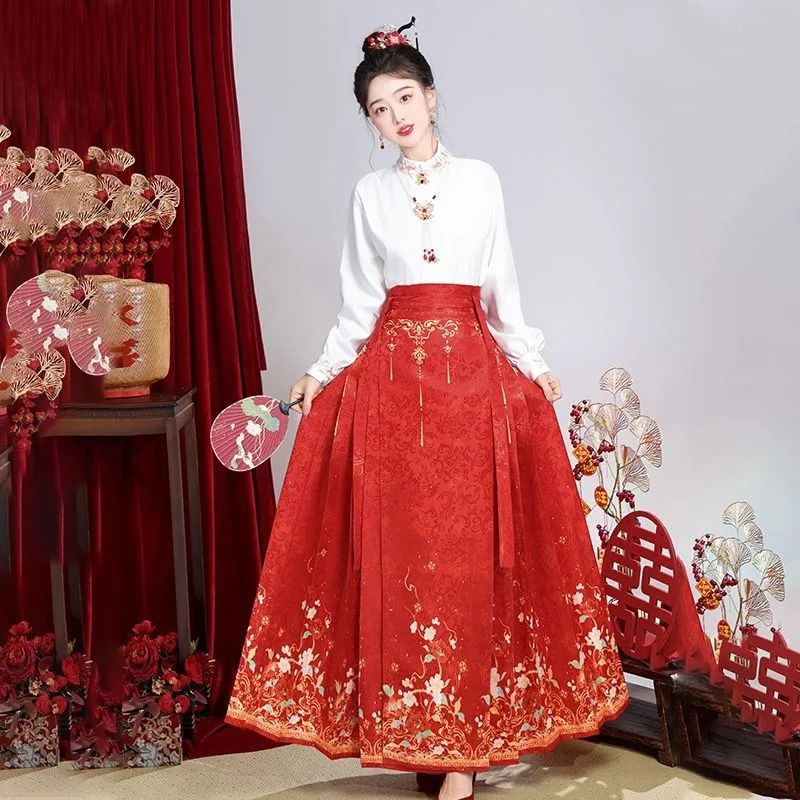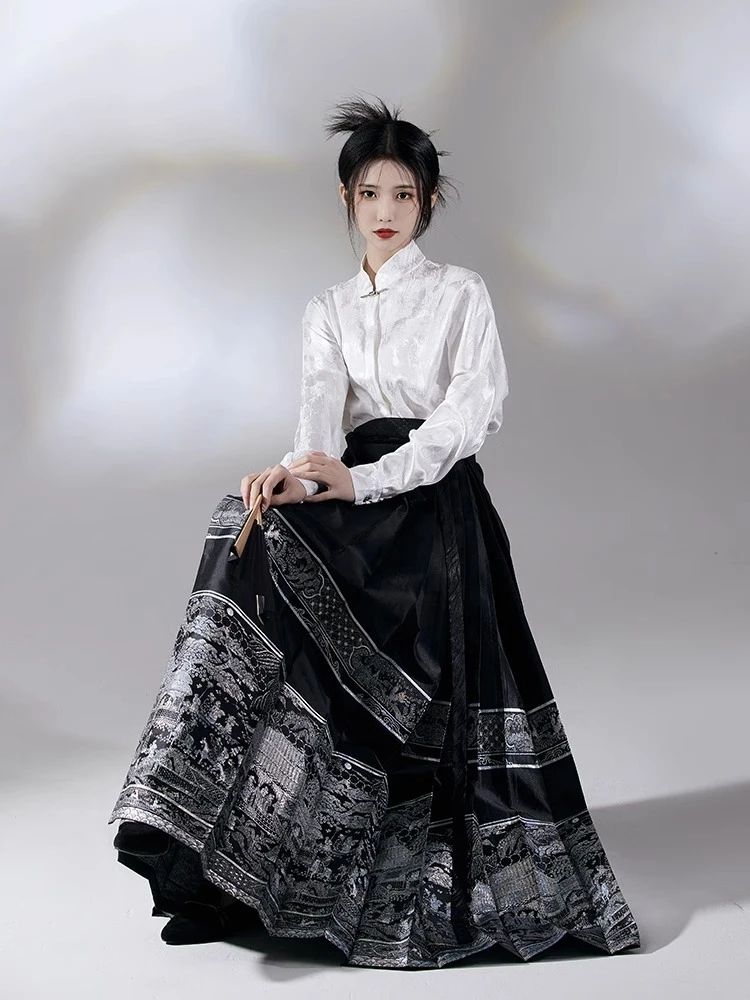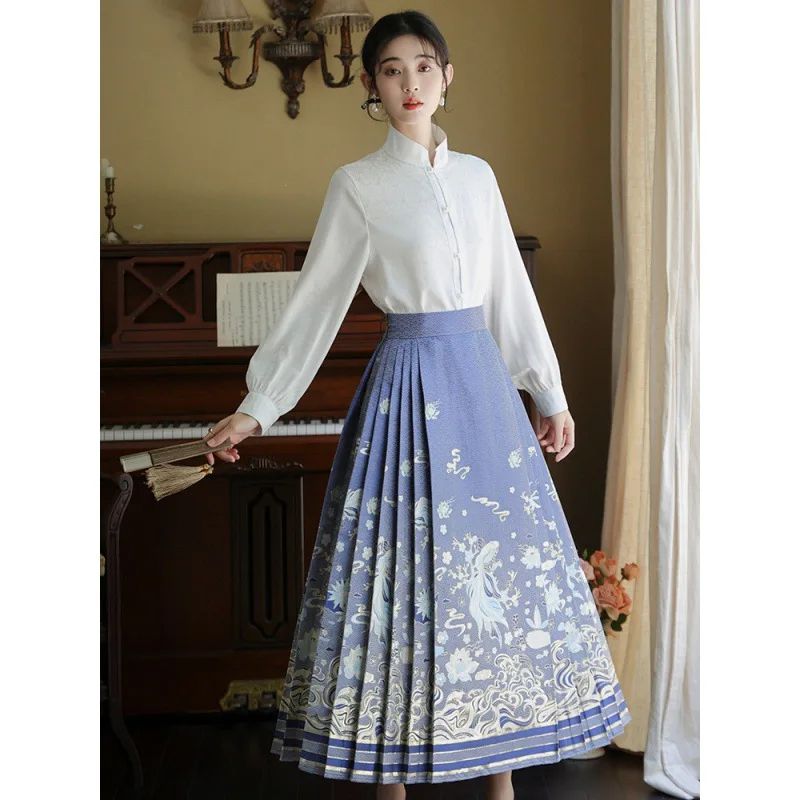The History and Evolution of Mamianqun: Tracing the Origins and Transformations of Hanfu‘s Horse-Face Skirt
Mamianqun, the iconic horse-face skirt of Hanfu, has experienced a remarkable revival in recent years. This resurgence has sparked a renewed interest in the history and evolution of this traditional garment.

Origins in the Han Dynasty
The origins of mamianqun can be traced back to the Han dynasty (206 BCE – 220 CE). During this period, femmes wore a type of skirt known as “qun,” which was characterized by its long, flowing shape and wide waistband. Over time, the qun evolved into the mamianqun, which featured a distinctive horse-head-shaped opening at the front.
Military Influence
The horse-face design is believed to have originated from the military uniforms of the Han dynasty. Soldiers wore skirts with a similar opening to facilitate horseback riding. The adoption of this design in women’s fashion symbolized the increasing influence of military culture on society.
Peak Popularity in the Dynastie Tang
During the Tang dynasty (618-907 CE), mamianqun reached its peak of popularity. Women of all social classes wore the skirt, which was often adorned with elaborate embroidery and embellishments. The horse-face opening became a symbol of elegance and femininity.
Decline in the Dynastie des Song
However, the popularity of mamianqun declined during the Song dynasty (960-1279 CE). The skirt was replaced by other styles, such as the “ruqun,” which was more modest and practical. Mamianqun continued to be worn by some femmes, but it became increasingly rare.
Revival in the 20th Century
In the 20th century, mamianqun experienced a revival as part of the Hanfu movement. This movement aimed to revive traditional Chinese clothing and promote cultural heritage. Hanfu enthusiasts began to wear mamianqun as a way to connect with their ancestors and celebrate Chinese culture.
Contemporary Significance
Today, mamianqun is widely worn by Hanfu enthusiasts and has become a symbol of Chinese cultural identity. It is often featured in fashion shows, cultural events, and online platforms. The revival of mamianqun has not only preserved a piece of Chinese history but has also fostered a sense of pride and cultural connection among its wearers.
Styling Mamianqun in Moderne Fashion: Contemporary Interpretations and Creative Combinations
Mamianqun, the iconic horse-face skirt of Hanfu, has experienced a remarkable revival in recent years. This traditional garment, characterized by its distinctive trapezoidal shape and flowing silhouette, has captivated fashion enthusiasts with its timeless elegance and versatility.

Growing Appreciation for Cultural Heritage
The resurgence of mamianqun can be attributed to the growing appreciation for Chinese cultural heritage and the desire for unique and expressive fashion. Contemporary designers have embraced this ancient garment, reinterpreting it in innovative ways while preserving its essential elements.
Modern Fabrics and Textures
One notable trend is the incorporation of modern fabrics and textures into mamianqun. Designers experiment with lightweight silks, sheer organza, and even metallic brocades, creating skirts that are both ethereal and eye-catching. The traditional horse-face shape remains intact, but the use of these contemporary materials adds a touch of modernity.
Eclectic Styling Combinations
Another creative approach involves combining mamianqun with other garments to create eclectic and stylish ensembles. Designers pair the skirt with tailored jackets, oversized sweaters, and even sneakers, blurring the lines between traditional and contemporary fashion. This fusion of styles allows for endless possibilities of expression.
Special Occasion Wear
Furthermore, mamianqun has become a popular choice for special occasions. Its elegant silhouette and rich cultural significance make it an ideal garment for weddings, festivals, and other formal events. Designers have created elaborate versions of the skirt, adorned with intricate embroidery, beading, and other embellishments, transforming it into a statement piece.
Celebrating Adaptability
The revival of mamianqun not only celebrates Chinese cultural heritage but also showcases the adaptability and creativity of contemporary fashion. By embracing this ancient garment and reinterpreting it in innovative ways, designers have created a versatile and stylish piece that transcends time and trends. As the popularity of mamianqun continues to grow, it is likely to remain a staple in the wardrobes of fashion-forward individuals who appreciate both tradition and modernity.
The Cultural Significance of Mamianqun: Exploring the Symbolism and Social Impact of Hanfu’s Horse-Face Skirt
Mamianqun, the iconic horse-face skirt of Hanfu, has experienced a remarkable revival in recent years. This resurgence has not only sparked a renewed appreciation for traditional Chinese tenue vestimentaire but also ignited discussions about its cultural significance and social impact.

Historical Context
Mamianqun, characterized by its distinctive trapezoidal shape and pleated front, originated during the Ming dynasty. Its name derives from its resemblance to a horse’s face, symbolizing strength and vitality. Traditionally worn by women of all social classes, it became a symbol of Chinese identity and cultural heritage.
Factors Behind Revival
The revival of mamianqun can be attributed to several factors. Firstly, the growing interest in Hanfu has led to a rediscovery of its various garments. Secondly, the rise of social media platforms has provided a space for enthusiasts to share their passion and inspire others. Moreover, the increasing awareness of Chinese culture globally has contributed to the skirt’s popularity beyond China.
Tangible Connection to Heritage
The cultural significance of mamianqun extends beyond its aesthetic appeal. It represents a tangible connection to China’s past and serves as a reminder of the country’s rich cultural traditions. By wearing mamianqun, individuals express their pride in their heritage and contribute to the preservation of Chinese culture.
Community and Economy
Furthermore, the revival of mamianqun has had a positive social impact. It has fostered a sense of community among Hanfu enthusiasts, who gather at events and online forums to share their knowledge and appreciation. Additionally, it has encouraged the development of small businesses specializing in the production and sale of Hanfu garments, contributing to the local economy.
Challenges and Critiques
However, the revival of mamianqun has also faced some challenges. Some critics argue that the focus on historical accuracy has led to a rigid interpretation of Hanfu, limiting creativity and innovation. Others express concerns about the commercialization of Hanfu, which they believe could undermine its cultural significance.
Conclusion
Despite these challenges, the revival of mamianqun remains a testament to the enduring power of Chinese culture. It has not only revitalized a traditional garment but also sparked a broader appreciation for China’s rich heritage. As the popularity of mamianquncontinues to grow, it is likely to play an increasingly important role in shaping the cultural landscape of China and beyond.
